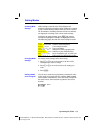
Operating the TI
-
83 1-13
8301OPER.DOC TI-83 international English Bob Fedorisko Revised: 02/19/01 12:09 PM Printed: 02/19/01 1:34
PM Page 13 of 24
On the TI
.
83 you can enter and use several types of data,
including real and complex numbers, matrices, lists,
functions, stat plots, graph databases, graph pictures, and
strings.
The TI
.
83 uses assigned names for variables and other
items saved in memory. For lists, you also can create your
own five-character names.
Variable Type Names
Real numbers
A
,
B
, . . . ,
Z
,
q
Complex numbers
A
,
B
, . . . ,
Z
,
q
Matrices
ã
A
ä
,
ã
B
ä
,
ã
C
ä
, . . . ,
ã
J
ä
Lists
L
1
,
L
2
,
L
3
,
L
4
,
L
5
,
L
6
, and user-
defined names
Functions
Y
1
,
Y
2
, . . . ,
Y
9
,
Y
0
Parametric equations
X
1T
and
Y
1T
, . . . ,
X
6T
and
Y
6T
Polar functions
r
1
,
r
2
,
r
3
,
r
4
,
r
5
,
r
6
Sequence functions
u
,
v
,
w
Stat plots
Plot1, Plot2, Plot3
Graph databases
GDB1
,
GDB2
, . . . ,
GDB9
,
GDB0
Graph pictures
Pic1
,
Pic2
, . . . ,
Pic9
,
Pic0
Strings
Str1
,
Str2
, . . . ,
Str9
,
Str0
System variables
Xmin
,
Xmax
, and others
•
You can create as many list names as memory will allow
(Chapter 11).
•
Programs have user-defined names and share memory
with variables (Chapter 16).
•
From the home screen or from a program, you can store
to matrices (Chapter 10), lists (Chapter 11), strings
(Chapter 15), system variables such as
Xmax
(Chapter
1),
TblStart
(Chapter 7), and all
Y=
functions (Chapters
3, 4, 5, and 6).
•
From an editor, you can store to matrices, lists, and
Y=
functions (Chapter 3).
•
From the home screen, a program, or an editor, you can
store a value to a matrix element or a list element.
•
You can use
DRAW STO
menu items to store and recall
graph databases and pictures (Chapter 8).
Using TI-83 Variable Names
Variables and
Defined Items
Notes about
Variables


















